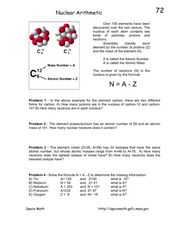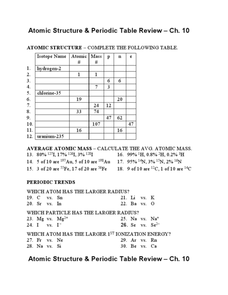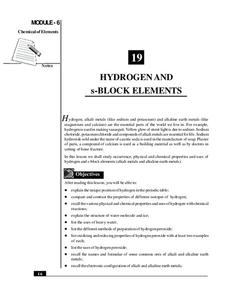Curated OER
Atomic Properties of The Elements
For this chemistry worksheet, learners examine the periodic table and how it is used in the context of interpreting compounds and their structure.
Curated OER
The Periodic Table
In this science learning exercise, students use a periodic table to complete the first four rows of a chart. Students use the Internet or research books to complete the last column.
Curated OER
Atomic Mass, Moles, and the Periodic Table
In this periodic table activity, students review atomic mass, molar mass, and percent composition of compounds. Then students complete 4 problems.
Curated OER
The Atom Board - Making Atoms
In this atom worksheet, chemists learn how to determine the number of protons, neutrons and electrons in an atom using the atomic mass and atomic number. They complete a chart of the subatomic particles and use marbles to represent...
Curated OER
Nuclear Arithmetic
In "Nuclear Arthmetic," first-time physical scientists examine atomic structure and the periodic table of elements. The are given the formula, "N = A-Z," in which N is the number of neutrons, A is the atomic mass, and Z is the atomic...
Curated OER
What Information is on the Periodic Table?
In this elements instructional activity, students review the information that is found on a periodic table including atomic mass, chemical symbol, atomic, number, and electron configuration. This instructional activity has 7 fill in the...
Curated OER
Atomic Structure and Periodic Table Review
In this atomic structure and periodic table worksheet, students complete a table with isotopes, their atomic masses, the number of protons, neutrons and electrons and mass number. They also find the average atomic mass of atoms and...
Curated OER
The Number of Neutrons
Although the focus of this learning exercise is the neutron, you cannot talke about them without also dealing with protons and electrons! Chemistry kids fill in a table of 14 elements, identifying the mass, atomic number, isotopic...
Curated OER
Chemistry Review
In this chemistry review worksheet, students identify chemical changes, isotopes, ions, and chemical bonds. This worksheet has 32 multiple choice questions.
Curated OER
Atomic Musical Chairs
An engaging activity enlightens young chemists in this lesson on atomic structure. They play musical chairs through a series of concentric circles that represent electon orbitals. A laundry basket in the middle holds the protons and...
Curated OER
The Periodic Table
In this periodic table worksheet, students review the elements and how they are organized in the periodic table. This worksheet has 10 fill in the blank, 6 multiple choice, and 5 short answer questions.
Curated OER
Atom Review
For this atom worksheet, students review the subatomic particles, the scientists associated with the atomic theory, and the periodic table. This worksheet has 15 matching, 24 fill in the blank, and 11 short answer questions.
Curated OER
Regents High School Examination PHYSICAL SETTING CHEMISTRY 2007
The University of the State of New York has designed a series of exams to be given to high schoolers. This chemistry exam is one of the most comprehensive and well-written that you will ever find. It consists of 84 questions in a variety...
Curated OER
Chemistry Foundations
Extensive notes on foundational chemistry concepts make up this resource. It summarizes the properties of matter, the periodic table, chemical nomenclature, and general chemical bonding. Design a set reading comprehension questions to go...
Curated OER
Protons, Neutrons, and Electrons
Using the periodic table of elements, young chemists fill in a chart of isotopes to show the atomic number, mass, charge, number of protons, number of neutrons, and number of electrons. The chart is followed by 11 questions that...
Curated OER
Building Blocks of Matter
In this science worksheet, students identify different parts of one element from the periodic table. Students also complete a chart by writing the appropriate characteristics for metals, metalloids, and nonmetals.
Curated OER
Atoms, Molecules, and Ions
In this molecules worksheet, students review the parts of an atom and use element mass to determine isotopes. Students give the group, period, and classification for the given elements. This worksheet has 6 short answer questions and 17...
Curated OER
Atoms and Chemical Bonding
An online resource, this worksheet has your chemistry learners complete four data tables with information about atoms and chemical bonds. The first table addresses atomic number and mass, as well as numbers of protons, neutrons, and...
Curated OER
Average Atomic Mass
Using a chart of student test grades as an example, curious chemists learn how to calculate weighted averages. They apply this knowledge to elements on the periodic table. As practice in calculating average atomic masses, learners...
Curated OER
A Guided Tour of the Periodic Table
In this periodic table worksheet, students write the chemical symbols for the given elements, compare atomic number and mass number, and describe the importance of valence electrons in the organization of the periodic table. This...
Curated OER
Nuclear Decay
In this nuclear decay worksheet, students read about alpha and beta decay and the isotopes formed by the reactions. Students solve nine problems including writing the equations for the decay of radioactive isotopes, identifying the...
Curated OER
Chemistry - Science 10
In this chemistry science worksheet, students identify the parts of a chemical reactions. Students name the major particles of the atom. Students apply knowledge about the atom, theories, and models.
Curated OER
Review for Chemistry
For this review for chemistry worksheet, students decide if given statements are true or false. Students relate information learned about introductory knowledge gained in chemistry to accurately answer the given questions.
National Institute of Open Schooling
Hydrogen and s-Block Elements
Lesson 19 in the series of 36 analyzes the element hydrogen and the s-block elements. Through readings, answering questions, and discussion, learners write about and explain their occurrence, physical and chemical properties, and...























